Galapagos Travel Guide
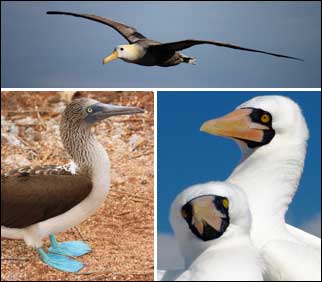 Best 5 islands
in the Galapagos
Best 5 islands
in the GalapagosEspanola
It is the southernmost island of the Galapagos Islands. Espanola teems with wildlife.
- Outstanding wildlife
Enjoy the most absorbing wildlife trail in the Galapagos. It starts at Punta Suarez. Explore the nesting site of nearly all of the world's waved albatrosses (top photo). They have wing spans up to 2.5 meters or 8 feet. Also walk through the well-populated nesting sites of both the blue-footed (bottom left) and the nazca (bottom right) boobies. And hike along a striking cliffscape. And you pass a mighty blow hole.
- Gardner Bay
Swim, snorkel and sunbathe at the white-sand, crescent-shaped.
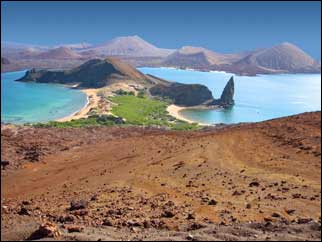 Bartolome
BartolomeThis small island has a Mars-like landscape, a photographer's dream.
-
Lookout
Hike up 379 steps to the lookout platform on Bartolome's volcano peak. You'll savor a panoramic view capturing the "Martian terrain" joined with a verdant isthmus featuring the jagged 30-meter (100-foot) high Pinnacle Rock. Santiago Island is in the background.
- Pinnacle Rock
Snorkel with the Galapagos penguins beneath the towering Pinnacle Rock.
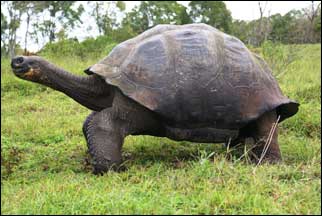 Santa Cruz
Santa CruzIt's the most populated island in the Galapagos and is centrally located. Puerto Ayora is the major town and has the most hotels, stores, and tour agents in the Galapagos archipelago.
-
Research Center
Visit the Charles Darwin Research Center to see the giant tortoises. Though the famous giant tortoise Lonesome George passed away, there are many equally large giant tortoises at the center.
- Lava tubes and giant tortoises
Go to the Santa Cruz highlands to walk through lava tubes and to observe wild giant tortoises roaming lush green landscapes.
 Fernandina
FernandinaThis is the westernmost, youngest and most volcanically active Galapagos island. Fernandina is also the most pristine because it was the least affected by man-introduced foreign animals and vegetation.
-
Flightless cormorants
Hike the trail that begins at Punta Espinoza to see the relatively rare flightless cormorants. Along the way you'll also view well-established marine iguana and sea lion colonies.
- Channel sailing
Watch pods of whales and orcas and schools of dolphins in the channel separating Fernandina and Isabela Islands.
San Cristobal
 It's the easternmost (and therefore may be the oldest) island of the Galapagos archipelago.
It's the easternmost (and therefore may be the oldest) island of the Galapagos archipelago.
-
Kicker Rock (Leon Dormido)
It's one of the Galapagos' most celebrated landmarks. This 146-meter (nearly 500-foot) high rock formation dramatically juts out of the sea near the San Cristobal coast. Circle the rock up close - and if you are in a small boat, you can pass completely through where the rock is split.
- Interpretation Center
Become eco-savvy at the Interpretation Center in Puerto Baquerizo, the second largest town in the Galapagos.
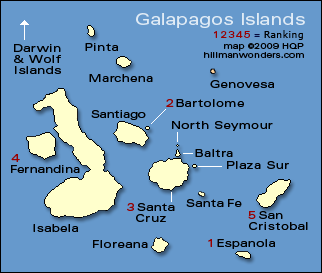
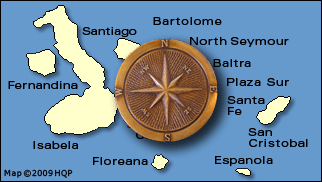
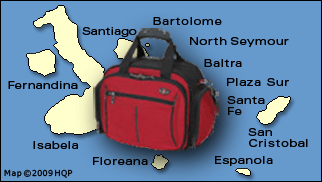
The runners-up
These didn't quite make my best 5 list, but they are commendable. List is alphabetical.
Darwin & Wolf Islands
Great scuba diving destinations. The area is off limits to non-divers. And no visitor - even divers - may step foot on the land.
Floreana
Its history includes a wild self-castaway, a floating post office barrel, an era of pirates and convicts, and the scandalous 1930's "Galapagos Affair". Punta Cormorant is the best visitor site. Just offshore from it is Devil's Crown - snorkelers adore it.
Isabela
This is the largest Galapagos island (about 125 kilometers or 80 miles long) and has the highest peak in the Galapagos. Isabela was formed by six volcanoes and their overlapping lava flows. Some visitor sites have volcano trails.
Genovesa
If you're in a small boat, you can sail into and anchor in a sea-breached, semi-submerged caldera. Darwin Bay and Prince Philip landing are good visitor sites. Genovesa has red-footed boobies.
Santiago
It has a scenic anchorage and landscape with several visitor sites: Sullivan Bay (for whirl-patterned lava field), Buccaneer Cove, and Puerto Egas (aka James Bay).
Seymour Norte
This small, flat island has highly visible blue-footed boobies, frigatebirds, sea lions, and both marine and land iguanas.
Well-known islands with serious drawbacks
Baltra
Its airport puts Baltra on the visitor's map. There's not much to see or do except shop at the airport's handicraft and souvenir stands.
Plaza Sur
A prolific colony of sea lions reside here. But sometimes day-trippers from Santa Cruz Island come in large numbers, ruining the ambiance.
Santa Fe
Snorkelers and birders like it. It's midway between Puerto Ayora on Santa Cruz and Puerto Baquerizo on San Cristobal, meaning a potential abundance of day-trippers.
Planning Tips
Itinerary variations
Many exist. But your cruise captain has little sway. The Galapagos National Park Service proscribes and enforces all itineraries. This includes the visitor sites and the hours of the day you can be there. The assignment system helps prevent overcrowding the wildlife and environment.
If you have a strong preference for visiting a particular island or visitor site, be sure to select a cruise that satisfies your desire.
Don't stay too short or too long
Typical cruise lengths vary in the Galapagos Islands from 4 days (3 nights) to a couple of weeks. With the first, you will miss some important shore excursion sites. And the second is too long for most travelers. For most visitors, a length of 8 days (7 nights) is ideal.
Avoid boats with split-week cruises
If you desire an 8-day (7-night) cruise, I strongly recommend that you don't book one that also sells half-week cruises. Such boats cannot travel to more distant islands because they have to return to their home port in the middle of their sailing week to disembark the half-week passengers and embark their replacements.
Think twice about staying in Galapagos hotels and taking day trips
Some travelers book hotels in the Galapagos towns Puerto Ayora or Puerto Baquerizo and take daytrips to nearby visitor sites. The drawback is you stay only in hotels and miss the joy of cruising on a sleep-aboard ship or yacht. And, although you visit nearby islands, you miss more distant islands, some of which are musts.
Off limits
Tourists are allowed to visit only a very small fraction of the Galapagos National Park. The rest is off limits. However, the allowable areas rank high in interest.
Each day is busy
The daily schedule is more or less the same for nearly every 8-day (7-night) cruise ship and yacht.
Morning
After an early breakfast, a Zodiac ferries you to a new landing site for a naturalist-guided walk or hike.
Midday
You return in time for lunch. Afterwards, you have ample time to nap, sunbathe on the deck, catch up on your reading, edit your digital photos, chat with friends, whatever. Meanwhile, your boat is sailing to your next landing site (on the same island or a new one).
Afternoon
You experience another Zodiac excursion adventure. This is often followed with swimming, snorkeling, or if you wish, a direct ride back to the ship.
Evening
It's cocktail and socializing time. Then it's dinner, followed or preceded by the daily briefing that describes tomorrow's landing sites. After that, some cruisers go directly to bed exhausted, others stay up and party.
Is the schedule too active and challenging?
No, not to the vast majority of visitors. They come to experience the Galapagos Islands. They want to maximize their Galapagos adventure. They know that this will likely be their first and last time in the Galapagos Islands.
However, if you're not up to schedule mentally or physically, remember that participation in each activity is optional (except for evening briefings and the one-time lifeboat drill).
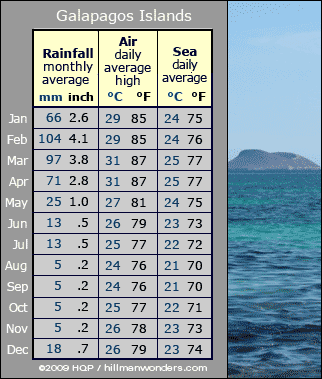 The "bad" Galapagos season
The "bad" Galapagos seasonThe Galapagos has none. Really. The climate is suitable for year-round visits. And wildlife viewing is always stimulating. Of course, each season has its advantages.
Just two climate seasons
Because the Galapagos Islands straddle the equator, the region does not have four seasons. It has two:
Wet season: January to March
Dry season: April to December
Myth:
The Galapagos Islands dry season is better than its wet one
For most travel destinations on our planet, the dry season is preferable to the wet one. In the Galapagos Islands, the opposite is true.
Consider:
Galapagos sky
The skies are more often gray than blue during the driest time of the year (June to December). This is especially true during August and September when persistent overcast and thin cloud layers filter the sunlight.
Rain
The rains during the Galapagos wet season (January to May) are short-lived and occur mainly in the afternoon. They pass quickly, leaving behind gorgeous blue skies and fostering green hillsides. Moreover, it rains less during the Galapagos Islands wet season than it does at most of the world's major tourist destinations.
Temperature
Air and sea temperatures are warmest in the wet season. During the dry time of the year, the temperatures in the Galapagos Islands can become a tad chilly (though it's not unpleasant if you're suitably dressed).
Galapagos sea condition
The sea is calmest in the wet season. During the dry period (and especially in August and September), the sea can become choppy. This could make your cruise boat pitch and roll more than usual (not good if you're prone to sea sickness). And, sea surges could add a level of difficulty to your shore excursion landings.
The high tourist seasons
The Galapagos has two
They are:
June to mid-September
mid-December to mid-January
There's also a tourist crush during the Easter holiday period.
Irony
The two high periods fall mainly in the dry season when you could encounter gray skies, restless seas, and slightly chilly temperatures.
Booking issues
During those periods, many cruise boats are fully booked a half year or more in advance. Even if you manage to secure a booking on short notice, you may have to settle for a boat, cabin, or itinerary that doesn't dovetail with your preferences.
The ideal 30-day period in the Galapagos
If there is one superior time to visit, it would be mid-April to mid-May. The skies are usually clear. The air and sea are relatively warm. The water is calm. Vegetation is green. Colorful wild flowers are abloom. And, it's not yet high season when boat, ship, tour, cruise, hotel, and air costs peak.
If you can go only in the second half of the year, choose mid-November to early December. Temperatures are on the rise, the sea is calmer, and the year's second high season doesn't begin until mid-December.
General packing advice
Pack lightly for the Galapagos Islands
You're going on a casual adventure, not a competitive fashion show. And the airlines serving the Galapagos allow only one checked bag per person - and it cannot weigh more than 20 kilograms (32 pounds).
Two dress periods
Daytime excursion and shipboard wear can be as casual as you like, within limits. For dinner, it's still casual, but knock it up a notch or two.
Basic packing checklist
- Comfortable rubber-sole walking shoes or lightweight hiking boots or sneakers with good traction (2 pairs)
- Water-friendly sandals for wet landings
- Light cotton shirts and blouses (long- and short-sleeved / sport and polo)
- Light cotton shorts, pants, skirts
- Light rain jacket or short poncho
- Windbreaker
- Wide-brimmed hat or billed cap with neck flap
- Sunglasses (with sufficient UV protection)
- Long and short sleeved polo shirts
- Light sweater (for cool-month nights)
- Waterproof day backpack
- Bathing suit (two)
- Snorkeling gear (if not provided)
- Camera and/or camcorder
- Small, lightweight binoculars
- Small flashlight (for emergencies)
- Toiletry kit (ask what the boat provides)
- Sun block (high SPF factor)
- Insect repellent
More helpful tips
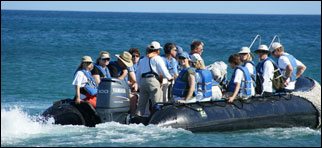 Dry and wet landings
Dry and wet landingsSome shore excursions have dry landings, others, wet landings. With the first, you step out of the Zodiac directly on a dock or lava rock. With the second, you slide over the edge of the Zodiac to land into ankle- or calf-deep water, then walk ashore. For the latter, water-friendly sandals are useful.
Trails
Hiking paths at the visitor sites sometimes cross small-boulder fields or rough lava terrain. This requires reasonable balance and sure-footedness. You also need to be in good physical shape because some hikes are long and one requires climbing 379 steps.
Hiking, though, normally goes at a leisurely pace with plenty of stops along the way to view the wildlife and listen to your naturalist's educational chat.
 Galapagos National
Park Rules
Galapagos National
Park RulesTo minimize the impact of visitors on the wildlife and environment, the park crafted strict rules.
They include:
- Do not set foot on the islands unless accompanied by a licensed guide,
- Do not stray from the marked paths.
- Do not touch, handle, feed, or water the wildlife.
- Do not use your camera flash when you are near the wildlife.
- Do not leave any litter on the islands, or toss anything off your boat or Zodiac.
- Do not remove or disturb anything (including a pebble or shell).
About naturalists
They are university graduates and have completed a comprehensive training course conducted by the Galapagos National Park Service. Unlike typical bus tour guides, naturalists have a love for and a deep knowledge of their subject - and they share it with you enthusiastically, not rotely.
The three official grades of naturalists are I, II and III. The first has the least qualifications and experience and works on the lower quality boats. The third is the most proficient. He or she works on the higher quality boats.
The difference between being guided by a top-grade naturalist and one who has not yet made that grade makes a profound difference in your Galapagos experience, understanding, and take-home knowledge. So be sure to inquire about the level of the naturalist(s) that will be on the boat before you book.
Sunburn
It's easy to get sunburned because the sun is directly overhead. This means there is less atmosphere to filter out the damaging rays. Use a high-factor sun screen. Wear a wide-brimmed hat or a long-billed cap. If the latter doesn't have a neck flap, wear a cotton neck scarf.
Smoking
A Galapagos cruise is not smoker friendly. Onboard, you can smoke only in designated outdoor decks. And you cannot smoke on a Zodiac or at a visitors site
Travel and medical insurance
Don't leave home without trip cancellation and trip interruption insurance. Ditto for medical insurance that fully covers you in Ecuador. The policy should also cover emergency evacuations. That's critical because the Galapagos Islands have no full-service hospital and emergency evacuation to the South American mainland is painfully expensive.
Not considering the child factor
- Child-free cruising
Should you desire a child-free boat cruise, think twice about going during the high seasons of the Galapagos Islands. That's when parents usually take their children because school vacation periods normally coincide with the high seasons.
- Family cruising
On the other hand, should you be taking your children and want them to be with other children, your best bet is to travel during the high seasons - and to book a cruise that lists itself as a family cruise.
- Age restrictions
Except in rare cases, children under 7 are not allowed to visit the Galapagos Island sites. Neither are those under 16 unless accompanied by an adult.
Some cruise boats have kayaks for their passengers. Often you have to share the available time with other guests. But a few small vessels are so kayak-focused that they have onboard enough kayaks for everyone.
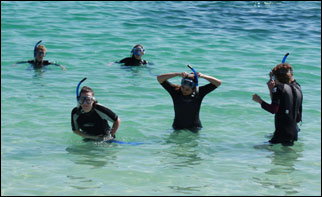 Snorkeling Tips
Snorkeling TipsWhy snorkeling in the Galapagos is special
The Galapagos Islands are heralded as a superb snorkeling destination by enthusiasts around the world. And a high percentage of the visitors who come to the islands participate.
Snorkeling emphasis
If you want to do a lot of snorkeling, pick a boat that emphasizes snorkeling on at least even footing with land excursions.
Snorkeling gear
Many cruise boat lend or rent (for a reasonable fee) snorkeling gear: mask, snorkel, fins, and sometimes wet suit. If the boat takes gear reservations, make them early for your sizes because sometimes the supply may be reserved by other passengers before you arrive. Better yet, bring your own gear to ensure availability, quality and good fit. (Note: A few boats like the Celebrity Xpedition cruise ship not only lend you the good-conditioned gear without charge, they stock an ample supply (including wet suits) to satisfy all their passengers.
Wet suit
From June to December, you will probably need a lightweight wet suit. However, in August and September, a medium weight wet suit is sometimes preferable.
Seasonal conditions
Be aware that currents can be strong during the dry season: From June to December, and particularly in August and September. (This issue is more critical for divers because they usually go farther off shore.
Most interesting snorkeling site
The favorite snorkeling site of most visitors is the one next to Pinnacle Rock on Bartolome Island. The setting is picturesque and chances are you will be snorkeling with frisky Galapagos penguins.
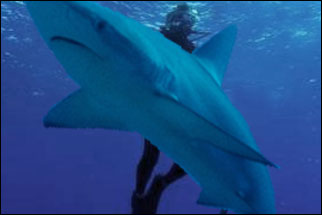 Diving tips
Diving tips Top 5 dive spots and areas
The Galapagos has numerous dive spots and areas - and everyone has his favorite. These are the best:
- Darwin and Wolf Islands
- Gordon Rock and the Plazas
- Devil's Crown
- Cousin's Rock
- Kicker Rock
The Galapagos Islands are widely considered one of the finest places on our planet for serious diving.
Needed diving proficiency level in the Galapagos
Nearly all Galapagos diving spots are recommended only for intermediate to advanced divers because of strong currents, low visibility, thermoclimes, cold water, compression chamber inaccessibility, and sizeable marine creatures (as large as whale sharks).
However, dive operators in Puerto Ayora have outings that take lower-skilled divers to nearby, less-challenging sites.
Helpful Galapagos diving pointers
Currents
They can be strong during the Galapagos Islands' dry season (June to December, and especially in August and September).
Trade off
The water is warmer, calmer, and clearer during the wet season ( January to May), but there are considerably more fish to observe in the dry season (June to December).
Availability
Few Galapagos cruise boats have SCUBA gear or even offer diving time. However, some vessels are happy to book a private dive boat with a PADI dive master for you. You do not need to go ashore. The diveboat picks you up and returns you to your cruise boat.
If you're keenly into diving
A small number of live-aboard Galapagos cruise boats specialize in diving, or devote much of their itinerary and schedule to it. The 16-passenger Sky Dancer is the best known one - and offers up to four dives a day. Other live-aboard choices include the Lammer Law and the Aggressor I and II.
Daytrip dives
You can book daytrip dives out of Puerto Ayora on Santa Cruz Island. But the best way to go is on a live-aboard. You'll visit a greater variety of dive spots.
Boat speed
Make sure your boat is a fast one, especially if you are going to distant islands. You don't want to eat up precious time traveling in a boat that you could be spending diving.
Shore excursions
If this is your first visit to the Galapagos Islands, be sure your diving vacation includes at least several shore excursions to see blue-footed boobies, land iguanas, giant tortoises, and other interesting land wildlife.


